Hope Amid the Uncertainty
Hard-won lessons from remote teaching, along with growing concerns over student well-being and enrollment rates, have spurred faculty and institutions to embrace new tools and approaches to improve the higher education experience. For the most part, students are responding favorably.
Click here to download a slideshow presentation of the report
Sixty-nine (69) percent of the 2,798 undergraduate students who participated in our December, 2021 survey agree their instructors excite them about learning – no small accomplishment in the face of uncertain times. Roughly the same percentage (70%) report feeling engaged and motivated in their courses. Three out of four say their instructors provide timely, helpful feedback (73%), along with the flexibility they need to be successful academically (74%). While perhaps not an ‘A’ grade, the learning experience for most students has been positive.
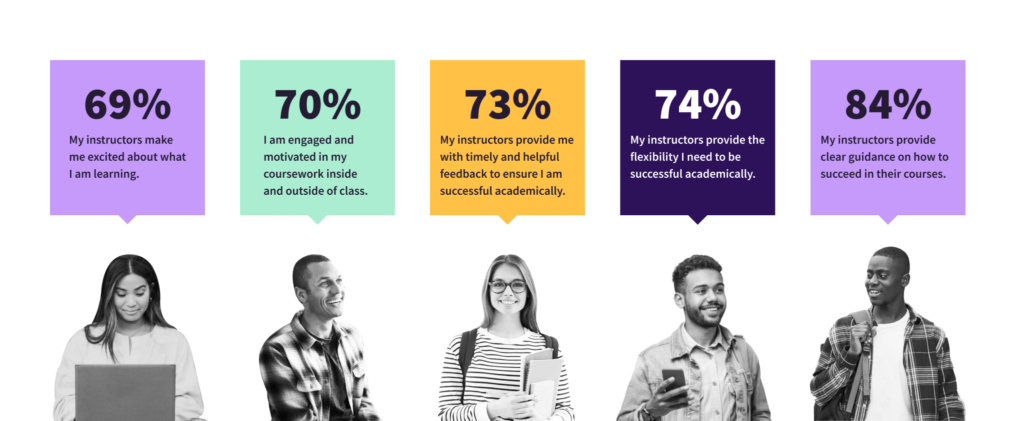
Career Readiness
Providing a counterpoint to the concern many have expressed about the readiness of graduates to succeed in the workforce, students appear overwhelmingly positive. Eighty-six (86) percent agree they are developing transferable skills while 72 percent say their instructors help them understand how what they are learning will support their career readiness after college. Overall, eight out of 10 believe they are gaining the skills and knowledge to succeed in the workplace.
Taken together, there are encouraging signs that one of the lasting effects of the pandemic has been a shift to more flexible and student-centric approaches to teaching that include a greater focus on preparing students for success outside of college.
Students in Distress
Despite the positives, concerns continue to grow over the cumulative impact of the pandemic on student health and wellbeing. According to a recent survey by TimelyMD, roughly nine in 10 college students believe their campuses are facing a mental health crisis. Six out of 10 respondents to our survey say they have experienced challenges with mental health and well-being since the start of the fall term. Of these students, 48 percent say these struggles have been extensive enough to affect their studies. These same individuals are far more likely to report feeling less excited about learning, less motivated, less connected to their instructors and are significantly less likely to feel comfortable participating in class or asking questions when feeling lost or confused.
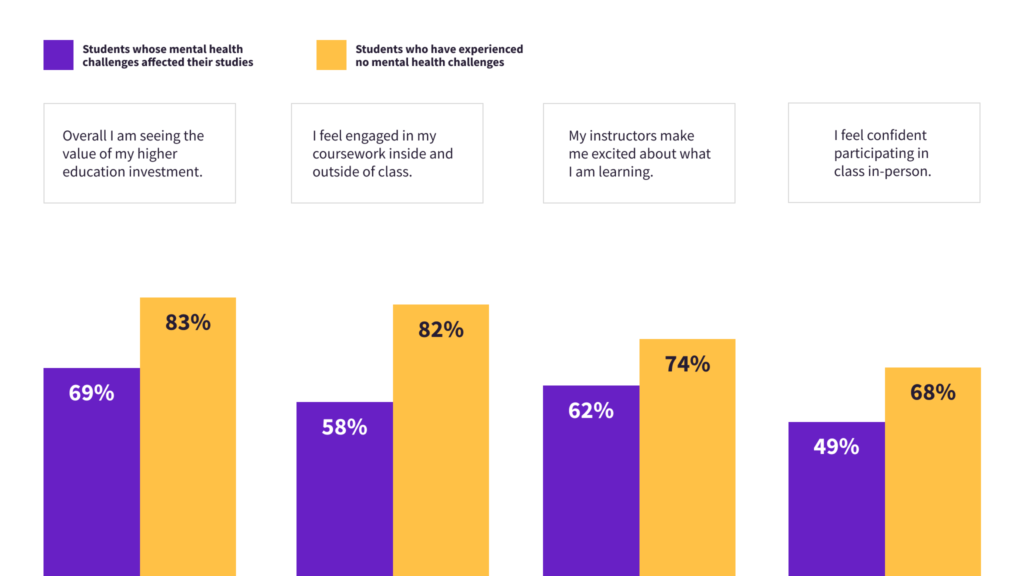
While there is a growing urgency for institutions to invest in overall student wellbeing, as our findings make clear, there are a number of opportunities to create more supportive, engaging and equitable experiences for all students.
Rethinking Student Assessments
One of the most interesting by-products of the pandemic has been the increased focus on changing the ways we assess students. The past two years saw many instructors assign “assessments for learning” rather than “assessments of learning.” Whether out of necessity, concern for student wellbeing, or the growing desire for more nuanced approaches to gauging student progress, the question now is whether these changes are taking root for the long term.
Here the picture is somewhat mixed. The vast majority of respondents (78%) indicate that their instructors rely primarily on high-stakes exams, contributing in part to the perception among half of students (53%) that their courses are designed to weed students out. This is hardly helpful to a cohort already contending with high rates of anxiety and depression. Nevertheless, there are indications that the momentum behind student-centric teaching in higher education is growing. A significant number of students (72%) agree that their instructors assess their performance in ways that allow them to demonstrate the full scope of their learning. Encouragingly, 62 percent say that their instructors design assessments as opportunities to learn rather than to simply test memorization.
What’s noteworthy is the effect of varying assessment techniques on the student experience. Students who agree their instructors assess performance in ways that allow them to “demonstrate the full scope” of their learning are more likely to say they feel connected to their instructors. They are also far more likely to feel confident asking questions when lost or confused compared to those whose instructors take a more narrow approach to assessments. Most interestingly, students provided with a mix of formative and summative assessments are also more likely to say they believe they are gaining the skills and knowledge to prepare them for success outside of college.
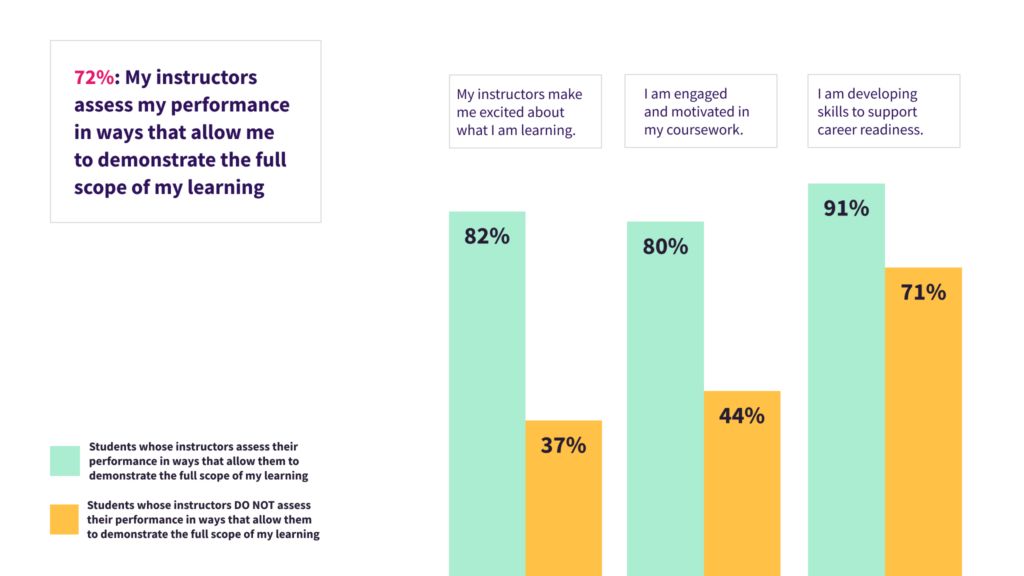
Keep the Feedback Coming
A core part of the value of an effective assessment strategy lies in the ongoing feedback opportunities this creates for students. And feedback, as we have been tracking for some time, has far-reaching effects. Among students who agree their instructors provide timely, constructive feedback, 84 percent say they feel they are seeing the value of their higher education investment compared to 55 percent of those who don’t receive feedback from their instructors. They are also more likely to report being engaged and motivated in their coursework and to feel connected to their instructors. We uncovered similar relationships for instructors who provide regular ‘nudges’ or reminders to ensure students stay on top of assignments and other coursework.
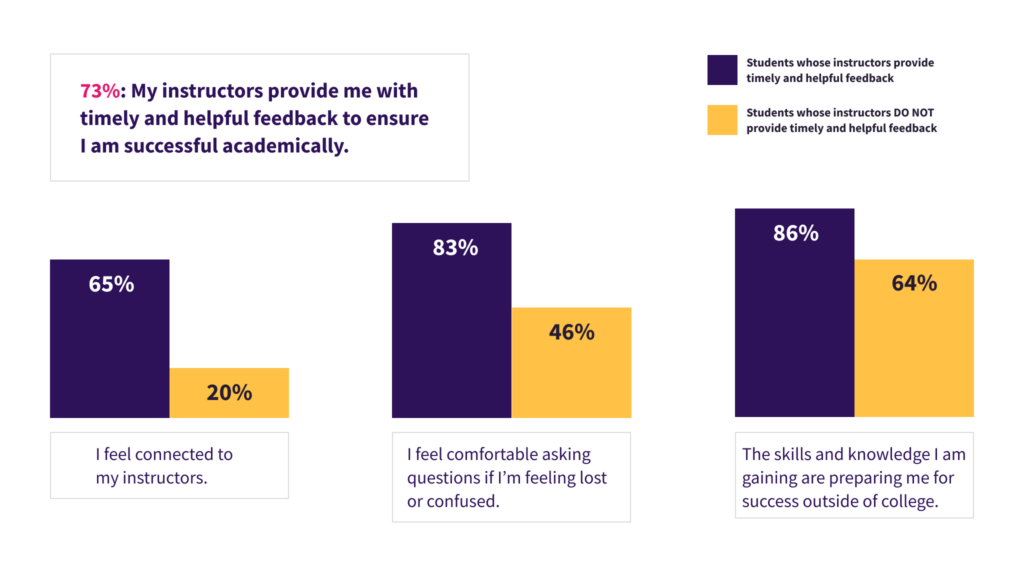
Leveling the Playing Field
In many ways, effective course design, including the use of learning platforms, is the foundation for accessible and equitable learning experiences. Yet for a significant number of students, the proliferation of learning technologies across classrooms over the past two years has created new impediments to success.
Roughly one quarter of respondents (27%) say they are being assigned too many different learning tools, while 16 percent acknowledge difficulties navigating these tools and a similar number (15%) report similar difficulties accessing online learning resources. While perhaps helping to improve flexibility at a time when it’s needed most, the patchwork of solutions institutions and faculty have implemented continue to present challenges to many. Consolidating and improving the integration between learning platforms should be an important priority.
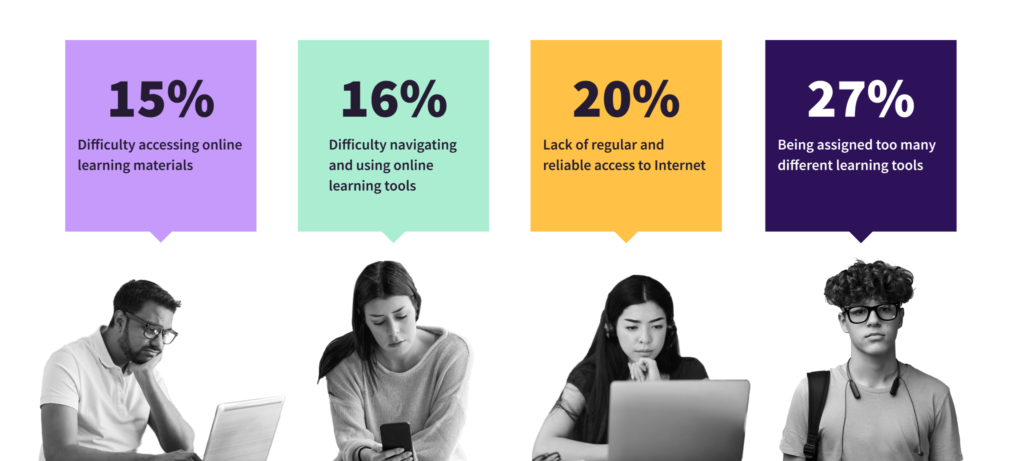
Reducing costs and complexity is important, but to level the playing field also means making diversity and inclusion a cornerstone of the learning experience. Content is one area where progress can be made quickly, especially with digital resources that can be updated more easily.
Eight out of 10 students say it’s important or very important that the content they use to support their learning include underrepresented individuals or groups and their contributions to a particular discipline. Mirroring the growing diversity of students on campuses, 67 percent say it’s important that they see individuals who represent their own identities and communities included in their learning. This is even more important to people who identify as visible minorities (78%) and people who identify as female (73%). Changes here may hold the added prospect of improving student outcomes. Forty (40) percent of all students agree that including underrepresented individuals and groups in textbooks and other materials increases their motivation to engage in the learning process.
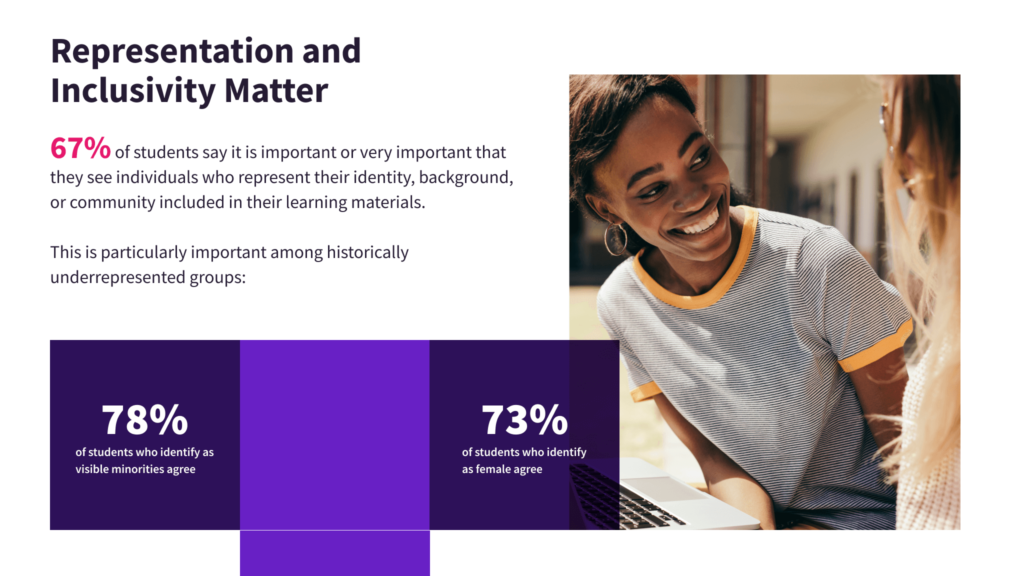
As we’ve tracked in our previous reports, community and belonging have an outsized impact on students’ perceptions of ROI. Focusing here can also pay dividends in fostering inclusive learning environments so fundamental to student engagement. Students who agree their instructors create a sense of community and belonging, are far more likely to feel excited about learning, to feel comfortable asking questions when lost or confused and to say they are motivated and engaged in their coursework compared to those who feel their instructors do not make community building a priority. Given the importance, there is room for improvement here given that 69 percent of students agree their instructors create a sense of community and belonging in the classroom.
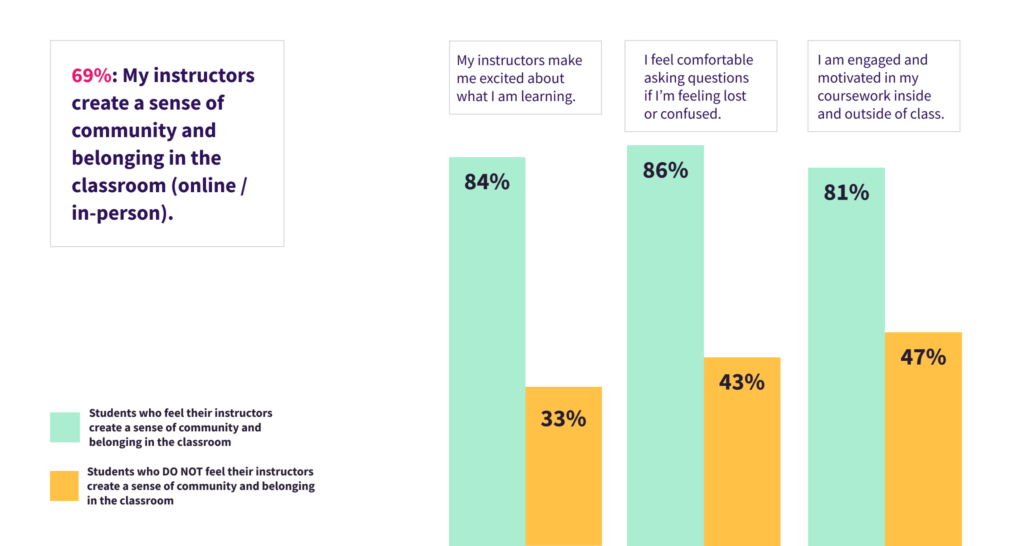
Takeaways
There are a number of opportunities to improve the overall learning experience and with it, student perceptions of the value of their higher education investment. Here are six key takeaways.
1. Lower the cost of educational resources
It seems obvious but even small steps here can create a powerful halo effect. Students who agree their instructors assign low- or no-cost learning materials are more likely to say they see value in their higher education than those who disagree (84 percent vs. 69 percent). OER content and flexible authoring tools now provide opportunities for educators to do just this.
2. Ensure diversity and representation in learning materials
Taking meaningful steps to include underrepresented groups and individuals in learning materials is not only important to students, it can help improve their motivation to engage in the learning process. Here again, the use of digital content is making it easier and faster to show progress in an area that clearly matters to students of all backgrounds.
3. Assign fewer tools
Tool proliferation is creating unnecessary obstacles and inconsistent learning experiences for too many students. Consolidating to focus on fewer, more effective tools will help reduce frictions, lower costs and make it easier for students (and faculty) to focus on learning.
4. Diversify assessment techniques
Offer a variety of formative and summative assessments that allow students to demonstrate the full scope of their learning. This not only correlates with the perception of educational ROI, getting students to apply knowledge in different ways also helps them feel better prepared for success after graduation.
5. Prioritize regular feedback
Timely, constructive feedback makes all the difference in supporting student success, confidence, and connection. Students who feel their instructors do a good job in this area report being more satisfied with their higher ed investment. They’re also more likely to believe they are gaining the skills and knowledge to succeed in the workplace.
6. Community, community, community
Community and belonging have significant effects on student engagement, participation, and motivation. Beyond showing a demonstrable impact on perceptions of educational ROI, creating environments where students feel known, understood and supported will help spur motivation and the willingness to engage both in and outside the classroom.
Click here to download a slideshow presentation of the report
About the Survey
The survey was conducted between December 8, 2021 and January 3, 2022. There were 2,798 total respondents with 42 percent from the United States and 58 percent from Canada. Eighty-six (86) percent were from four-year public institutions, 11 percent from four-year private institutions and three percent from two-year public institutions. Thirty-eight (38) percent identified themselves as first-year students, 30 percent as second year, 16 percent as third year and 11 percent as fourth year with five percent indicating ‘other.’


